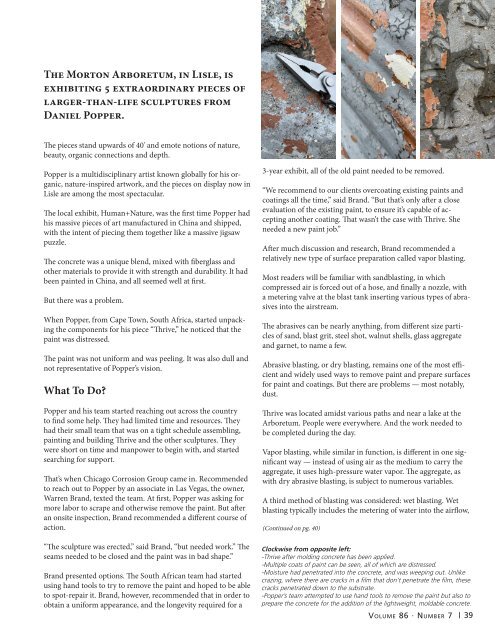CEAC-2021-07-July
Create successful ePaper yourself
Turn your PDF publications into a flip-book with our unique Google optimized e-Paper software.
The Morton Arboretum, in Lisle, is<br />
exhibiting 5 extraordinary pieces of<br />
larger-than-life sculptures from<br />
Daniel Popper.<br />
The pieces stand upwards of 40' and emote notions of nature,<br />
beauty, organic connections and depth.<br />
Popper is a multidisciplinary artist known globally for his organic,<br />
nature-inspired artwork, and the pieces on display now in<br />
Lisle are among the most spectacular.<br />
The local exhibit, Human+Nature, was the first time Popper had<br />
his massive pieces of art manufactured in China and shipped,<br />
with the intent of piecing them together like a massive jigsaw<br />
puzzle.<br />
The concrete was a unique blend, mixed with fiberglass and<br />
other materials to provide it with strength and durability. It had<br />
been painted in China, and all seemed well at first.<br />
But there was a problem.<br />
When Popper, from Cape Town, South Africa, started unpacking<br />
the components for his piece “Thrive,” he noticed that the<br />
paint was distressed.<br />
The paint was not uniform and was peeling. It was also dull and<br />
not representative of Popper’s vision.<br />
What To Do?<br />
Popper and his team started reaching out across the country<br />
to find some help. They had limited time and resources. They<br />
had their small team that was on a tight schedule assembling,<br />
painting and building Thrive and the other sculptures. They<br />
were short on time and manpower to begin with, and started<br />
searching for support.<br />
That’s when Chicago Corrosion Group came in. Recommended<br />
to reach out to Popper by an associate in Las Vegas, the owner,<br />
Warren Brand, texted the team. At first, Popper was asking for<br />
more labor to scrape and otherwise remove the paint. But after<br />
an onsite inspection, Brand recommended a different course of<br />
action.<br />
“The sculpture was erected,” said Brand, “but needed work.” The<br />
seams needed to be closed and the paint was in bad shape.”<br />
Brand presented options. The South African team had started<br />
using hand tools to try to remove the paint and hoped to be able<br />
to spot-repair it. Brand, however, recommended that in order to<br />
obtain a uniform appearance, and the longevity required for a<br />
3-year exhibit, all of the old paint needed to be removed.<br />
“We recommend to our clients overcoating existing paints and<br />
coatings all the time,” said Brand. “But that’s only after a close<br />
evaluation of the existing paint, to ensure it’s capable of accepting<br />
another coating. That wasn’t the case with Thrive. She<br />
needed a new paint job.”<br />
After much discussion and research, Brand recommended a<br />
relatively new type of surface preparation called vapor blasting.<br />
Most readers will be familiar with sandblasting, in which<br />
compressed air is forced out of a hose, and finally a nozzle, with<br />
a metering valve at the blast tank inserting various types of abrasives<br />
into the airstream.<br />
The abrasives can be nearly anything, from different size particles<br />
of sand, blast grit, steel shot, walnut shells, glass aggregate<br />
and garnet, to name a few.<br />
Abrasive blasting, or dry blasting, remains one of the most efficient<br />
and widely used ways to remove paint and prepare surfaces<br />
for paint and coatings. But there are problems — most notably,<br />
dust.<br />
Thrive was located amidst various paths and near a lake at the<br />
Arboretum. People were everywhere. And the work needed to<br />
be completed during the day.<br />
Vapor blasting, while similar in function, is different in one significant<br />
way — instead of using air as the medium to carry the<br />
aggregate, it uses high-pressure water vapor. The aggregate, as<br />
with dry abrasive blasting, is subject to numerous variables.<br />
A third method of blasting was considered: wet blasting. Wet<br />
blasting typically includes the metering of water into the airflow,<br />
(Continued on pg. 40)<br />
Clockwise from opposite left:<br />
-Thrive after molding concrete has been applied.<br />
-Multiple coats of paint can be seen, all of which are distressed.<br />
-Moisture had penetrated into the concrete, and was weeping out. Unlike<br />
crazing, where there are cracks in a film that don’t penetrate the film, these<br />
cracks penetrated down to the substrate.<br />
-Popper’s team attempted to use hand tools to remove the paint but also to<br />
prepare the concrete for the addition of the lightweight, moldable concrete.<br />
Volume 86 · Number 7 | 39


















